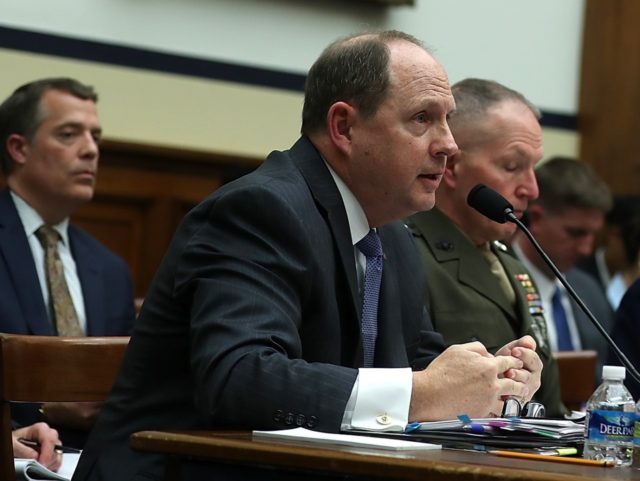Top military leaders’ concerns over how the Obama administration’s transgender policy would affect military readiness prompted the Trump administration to review the policy and enact the new one that went into effect Friday, according to a senior Pentagon official.
Anthony Kurta (pictured), who is performing the duties of the deputy undersecretary of defense for personnel and readiness, told reporters Friday at an on-the-record Pentagon briefing on Friday that it was the military service leaders that asked for a review of the previous policy, not President Trump.
“When Secretary Mattis came in to office, he was approached by the service leadership because we were getting ready to, under the 2016 [former Defense Secretary Ash] Carter policy, we were getting close to starting the accession of transgender individuals,” Kurta said.
Kurta explained the background of how the new transgender policy came to be enacted.
“The service leaders expressed some readiness reservations to the secretary, and he said therefore, ‘I will take a look at the policy,’ and he ordered a review of that policy, later to include empaneling the panel of experts and then that panel made a recommendation to the secretary. He took that onboard, gave his best military advice to the president, the president approved that recommendation and told him to go ahead and implement the policy,” Kurta said.
Kurta said all of this was before Trump tweeted a series of tweets in late July 2017 that said the U.S. government “would not allow transgender individuals to serve in any capacity in the U.S. military.”
Kurta said the military chiefs brought their concerns to Mattis shortly after he came to office, and that he could not speak to what they told him, or what their readiness concerns were, but said, “they were such that the secretary said we need to take a look at this.”
He added the 2016 Obama administration policy decision to allow current transgender service members to serve in their preferred gender and new recruits to serve in their preferred gender if deemed stable for 18 months, was made without any data.
“What we didn’t have under the 2016 policy was any data about what was happening to transgender service members or those with gender dysphoria in the military. We just didn’t have any history or any data. So [Mattis] said conduct a review, look at how we are treating soldiers, sailors, airmen and Marines with gender dysphoria, how they’re being employed in our units, basically take data that we didn’t have the first time, look at all of that, and give me a recommendation anew,” Kurta said.
“And all that was prior to the tweet,” he added.
Kurta said that Mattis put together a panel of experts consisting of senior military personnel both officer and enlisted, and senior civilian personnel. He said they talked to civilian medical providers, military medical providers, transgender service members currently serving, and also talked with the commanders of those transgender service members.
“Unlike the working group that came up with the 2016 policy, we also had access to our own medical data, of those who have been diagnosed with gender dysphoria over the past 18 months or so. Having looked at all of that data, tasked by the secretary with using their best individual military judgment, the panel made a recommendation for the policy as you see it today, to the secretary. He gave it an independent scrub himself,” Kurta added.
“Obviously [Mattis] has great experience himself in the military, and he made an independent military judgment based on that device and you know, his own experience, made a recommendation to the president, the president approved it, and that’s the policy we’re implementing today,” he said.
Kurta is a retired Navy rear admiral and civil servant at the Pentagon, who also served as deputy assistant secretary of defense for military personnel policy under the Obama administration.
Despite the concerns over the 2016 transgender policy arising from the military chiefs, progressive groups and activists have blamed President Trump and Vice President Mike Pence for wanting to kick out transgender service members from the military and have portrayed the new policy as a “ban.”
Under the new policy, all transgender service members who are currently serving will be grandfathered in under the 2016 policy. That includes those members not diagnosed with gender dysphoria, and those who have already been diagnosed with gender dysphoria as of Friday, April 12, 2019.
However, if those who were not diagnosed with gender dysphoria by that date are later diagnosed with gender dysphoria, they could be referred to the disability evaluation system for possible discharge from the military, depending on the treatment required.
New transgender recruits would need to serve in their birth sex under the new policy. Those diagnosed with gender dysphoria can serve if they have been deemed stable for 36 months in their biological sex by a medical professional and meet applicable standards. Kurta said no troops will be denied reenlistment or accession into the military based on their gender alone.
Kurta said it is difficult to know how many troops will be affected by the policy, since the Pentagon has no official statistics on transgender individuals.
However, he said according to a 2016 workplace and gender survey, just shy of 9,000 people in the military considered themselves transgender, and approximately 1,400 have been diagnosed with gender dysphoria. He said he estimates about just over 1,000 transgender individuals with gender dysphoria are in the active force.

COMMENTS
Please let us know if you're having issues with commenting.